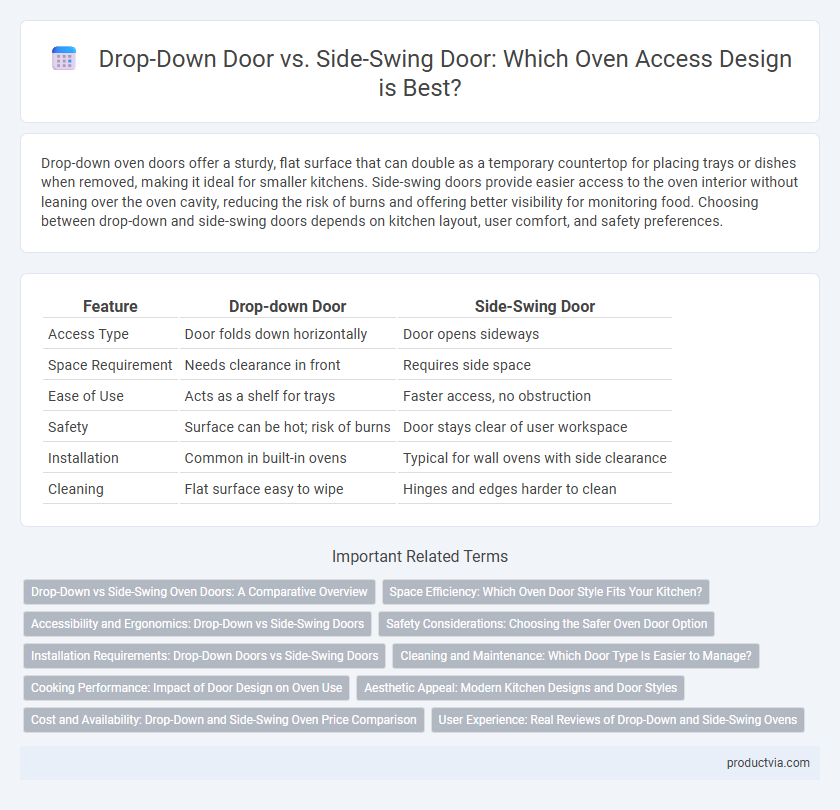Drop-down oven doors offer a sturdy, flat surface that can double as a temporary countertop for placing trays or dishes when removed, making it ideal for smaller kitchens. Side-swing doors provide easier access to the oven interior without leaning over the oven cavity, reducing the risk of burns and offering better visibility for monitoring food. Choosing between drop-down and side-swing doors depends on kitchen layout, user comfort, and safety preferences.
Table of Comparison
| Feature | Drop-down Door | Side-Swing Door |
|---|---|---|
| Access Type | Door folds down horizontally | Door opens sideways |
| Space Requirement | Needs clearance in front | Requires side space |
| Ease of Use | Acts as a shelf for trays | Faster access, no obstruction |
| Safety | Surface can be hot; risk of burns | Door stays clear of user workspace |
| Installation | Common in built-in ovens | Typical for wall ovens with side clearance |
| Cleaning | Flat surface easy to wipe | Hinges and edges harder to clean |
Drop-Down vs Side-Swing Oven Doors: A Comparative Overview
Drop-down oven doors provide easy access by lowering the door horizontally, allowing users to slide trays in and out effortlessly while offering a sturdy surface for placing hot dishes. Side-swing oven doors, hinging on the side, open vertically and can be more convenient in tight kitchen spaces by avoiding the need to kneel or lean over a lowered door. Each design affects kitchen ergonomics and safety differently, with drop-down doors preferred for their multi-functional surface and side-swing doors favored for quick access in compact layouts.
Space Efficiency: Which Oven Door Style Fits Your Kitchen?
Drop-down oven doors maximize space efficiency by folding down and providing a sturdy platform for handling hot dishes, making them ideal for kitchens with limited side clearance. Side-swing doors require ample lateral space to open fully, which can be restrictive in compact kitchens but offer easy access without bending over. Choosing between drop-down and side-swing doors depends on your kitchen layout, with drop-down doors fitting tighter spaces and side-swing doors suiting wider, open areas.
Accessibility and Ergonomics: Drop-Down vs Side-Swing Doors
Drop-down oven doors provide a stable platform for placing hot dishes, improving accessibility and minimizing the risk of burns, especially in compact kitchens. Side-swing doors open outward, offering unobstructed access to the oven cavity without bending, which enhances ergonomic comfort for users with mobility issues. Choosing between these door types depends on kitchen layout and user preferences for ease of reach and safety during cooking tasks.
Safety Considerations: Choosing the Safer Oven Door Option
Drop-down oven doors provide a stable platform when open, reducing the risk of hot spills and offering a safer surface for placing trays. Side-swing doors allow easier access without bending, minimizing burn hazards from hot surfaces and providing better visibility when reaching inside. Selecting an oven door type should prioritize minimizing burn risks and ensuring secure handling of hot cookware.
Installation Requirements: Drop-Down Doors vs Side-Swing Doors
Drop-down oven doors require sturdy hinges capable of supporting the door's full weight when open, demanding precise cabinet alignment and reinforcement for safe installation. Side-swing doors need sufficient lateral clearance to open fully without obstruction, making them ideal for kitchens with ample side space but necessitating careful consideration of adjacent cabinetry or appliances during installation. Both door types must comply with manufacturer specifications to ensure safety, functionality, and ease of access in varied kitchen layouts.
Cleaning and Maintenance: Which Door Type Is Easier to Manage?
Drop-down oven doors typically offer easier access for cleaning and maintenance because the door lies flat when open, allowing unobstructed reach to the interior and oven racks. Side-swing doors can obstruct access to the oven's interior edges and hinges, making thorough cleaning more challenging, especially in tight kitchen spaces. For homeowners prioritizing ease of cleaning, drop-down doors provide simpler maintenance with fewer hard-to-reach spots.
Cooking Performance: Impact of Door Design on Oven Use
Drop-down doors provide a sturdy, horizontal surface that can support heavy cookware during loading and unloading, enhancing safety and convenience. Side-swing doors offer easier lateral access, allowing better maneuverability for quick checking and basting, which can improve cooking precision. The door design influences heat retention and airflow, with drop-down doors often creating a better seal, thus maintaining consistent oven temperature and optimizing cooking performance.
Aesthetic Appeal: Modern Kitchen Designs and Door Styles
Drop-down oven doors offer a sleek, streamlined look that complements modern kitchen designs with minimalistic aesthetics. Side-swing doors provide a more traditional appearance, often favored in kitchens emphasizing classic or farmhouse styles. Choosing between these door styles impacts overall kitchen flow and visual harmony, aligning with contemporary trends or timeless elegance.
Cost and Availability: Drop-Down and Side-Swing Oven Price Comparison
Drop-down oven doors generally come at a lower cost due to simpler hinge mechanisms and higher market availability, making them a budget-friendly option for most consumers. Side-swing oven doors tend to be pricier, attributed to more complex hardware and less common designs, which can limit availability in some regions. Consumers seeking affordable and widely accessible ovens often find drop-down doors offer better value without compromising essential functionality.
User Experience: Real Reviews of Drop-Down and Side-Swing Ovens
Drop-down oven doors offer users a stable surface to rest cookware while providing easy access, which many real reviews highlight as convenient for heavy or large dishes. Side-swing doors, praised for their space-saving design, allow easier access in tight kitchens and improved visibility without needing to bend down as much. User feedback emphasizes that the choice depends on kitchen layout and cooking habits, with drop-down doors favored for traditional setups and side-swing doors preferred in compact, modern spaces.
Drop-down door vs Side-swing door for oven access Infographic

 productvia.com
productvia.com